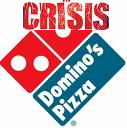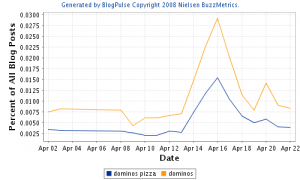Crises Management – Domino’s Case Study Research
Corporate Crisis Management:
Corporate crisis is defined as an unexpected event that creates uncertainty and threatens an organization’s priority goals and public image.
Managers facing crises as such consider the possible consequences of their reaction. On one side – reacting to uncontrolled events may foster further awareness to the problem. On the other side, ignoring such events may result in risking social legitimacy (the firm may be perceived as being irresponsible, dishonest, or acting in a manner that exhibits little concern for the community).
Bradford and Garrett (1995) investigated the effectiveness of five different corporate responses to a crisis event. The possible responses were (a) no response, (b) denial, (c) offer an excuse, (d) agree that the firm caused the event but argue that the severity of the event is less than publicized, and (e) agree that the event is severe and accept responsibility for the event.
The possible conditions were (a) the firm can provide evidence that they committed no unethical action, (b) the firm can provide evidence that they had no control over the event, (c) the firm can provide evidence that the event is less severe than suggested in the media, and (d) the firm accepts responsibility for the event.
Across the different conditions, the “accept responsibility” response was found to be the optimal communication strategy.
Other research in this field indicate that consumer expectations about the firm (consumers with a preexisting favorable opinion of a firm vs those who lacked a preexisting favorable opinion – Dawar & Pillutla, 2000) and their commitment to the brand ( low versus high commitment – Ahluwalia et al. , 2000) moderates the effects of negative publicity.
In this week Domino’s Pizza crisis, the firm decided to react to the event (taking 48 hours respond). They have presented an apology, suggested information (both public and personal) and a promise for taking future steps. Interestingly, it chose unconventional media channels to confront their consumers, the same channels in which the crisis found its way through – social media interactions.
Consumer research will be needed to test consumers’ perceptions and behaviors in few months time. Currently, it seems that although the images were shocking, the company has succeeded in reacting well to the event. Online trend tools indicate that the buzz around it lost an interest.
twitter trends:
blog citations:
search volume:
Description of the crisis:
On the night of April 13, two Domino’s employees engaged in an act of food violation posted their acts on YouTube (putting cheese in their nose, blowing mucous on a sandwich etc). The videos went viral online, viewed by millions of people until blocked.
Reactions to the crisis:
TrendsSpotting gathered Domino’s immediate actions as covered by different articles published on Advertising Age
April 14:
1. The employees were fired and warrants were issued for their arrest.
2. Domino’s has also posted a statement on its corporate website.
“The opportunities and freedom of the internet is wonderful, but it also comes with the risk of anyone with a camera and an internet link to cause a lot of damage, as in this case, where a couple of individuals suddenly overshadow the hard work performed by the 125,000 men and women working for Domino’s across the nation and in 60 countries around the world” .
3. On an interview with Domino’s spokesman he says: “Nothing is local anymore, that’s the challenge of the Web world. Any two idiots with a video camera and a dumb idea can damage the reputation of a 50-year-old brand.”
4. The company decided not to issue a press release. Dominos spokesman was interviewed on that: “the company can deal with tens of thousands of impressions, but a strong response from Domino’s would alert more consumers to the embarrassment.”
5. The company shared an apologetic e-mail from the employees: “It was all a prank and me nor Michael expected to have this much attention from the videos that were uploaded! No food was ever sent out to any customer. We would never put something like that on you tube if it were real!! It was fake and I wish that everyone knew that!”
April 15: Domino’s activated social media activities:
6. In a YouTube video, Patrick Doyle, president of Domino’s USA, apologizes for the incident, and describes the steps his company is taking to ensure such an incident doesn’t happen again.
“We sincerely apologize for this incident, we thank members of the online community who quickly alerted us and allowed us to take immediate action. Although the individuals in question claim it’s a hoax, we are taking this incredibly seriously.” Moreover, he said that the Conover store has been shut down and is being sanitized from top to bottom and promises to make sure “that people like this don’t make it into our stores.”
6. Dominos started social media activity on twitter (under the username “dpzinfo” – it receives 1425 followers as for today). With public information and personal twits (for example: “Most of our stores are designed so that anyone in the lobby can fully see the food prep area.”) information on the brand and on preventive acts are presented.
Examples of other corporate crises:
Johnson & Johnson’s response to the Tylenol incident – 1982
An unknown terrorist spiked Tylenol capsules with cyanide which resulted in seven deaths. Media coverage made it clear that Johnson & Johnson had no control over this post manufacture product tampering, suppressing any Could counterfactuals.
The actions taken by Johnson & Johnson were considered as highly effective:
The company recalled extra-strength Tylenol from all store shelves across the country, offered a reward for the murderer, and introduced a tamper resistant package. In this case, although the brand’s market share fell sharply (from 35% to 8%), it has recovered within a year.
Burger King employee takes bath in the burger chain’s sink
Alleged defects in tires manufactured by Firestone
Gene-spliced corn contamination of Taco Bell products
Benzene contamination in Perrier bottled water
Racial discrimination by Texaco in the promotion of employees
Academic references:
Ahluwalia, R., Burnkrant, R. E., & Unnava, H. R. (2000). Consumer response to negative publicity: The moderating role of commitment. Journal of Marketing Research, 37, 203-214.
Bradford, J. L., & Garrett, D. E. (1995). The effectiveness of corporate communicative responses to accusations of unethical behavior. Journal of Business Ethics, 14, 875-892.
Dawar, N., & Pillutla, M. M. (2000). Impact of product-harm crises on brand equity: The moderating role of consumer expectations. Journal of Marketing Research, 37, 215-226.
Murray, E., & Shohen, S. (1992). Lessons from the Tylenol tragedy on surviving a corporate crisis. Medical Marketing & Media, 27, 14-19.
update: View Slides presentation – Crises Management: Trendsspotting Insights On Dominos Case Study
![]() Tweet This Post
Tweet This Post ![]() Plurk This Post
Plurk This Post ![]() Buzz This Post
Buzz This Post ![]() Delicious
Delicious ![]() Digg This Post
Digg This Post ![]() Ping This Post
Ping This Post ![]() Reddit
Reddit ![]() Stumble This Post
Stumble This Post










![Validate my RSS feed [Valid RSS]](http://www.trendsspotting.com/blog/wp-content/images/valid-rss.png)


May 14th, 2009 at 9:43 pm
What are the techniques for equity research?
December 3rd, 2010 at 11:16 am
Just wondering–Should the word crisis be spelled “Crises?”
January 19th, 2011 at 3:59 pm
@Lindsey, crisis is singular noun.
Crises is plural. 🙂
February 7th, 2013 at 3:50 am
[…] Corporate Crisis Management: Corporate crisis is defined as an unexpected event that creates uncertainty and threatens an organization’s priority goals and public image. Managers facing crises as such consider the possible consequences of their reaction. On one side – reacting to uncontrolled events may foster further awareness to the problem. On the other side, ignoring such events may result in risking social legitimacy (the firm may be perceived as being irresponsible, dishonest, or acting in a manner that exhibits little concern for the community). Click here to read more… […]
January 21st, 2015 at 8:06 am
[…] Corporate Crisis Management: Corporate crisis is defined as an unexpected event that creates uncertainty and threatens an organization’s priority goals and public image. Managers facing crises as such consider the possible consequences of their reaction. On one side – reacting to uncontrolled events may foster further awareness to the problem. On the other side, ignoring such events may result in risking social legitimacy (the firm may be perceived as being irresponsible, dishonest, or acting in a manner that exhibits little concern for the community). Click here to read more… […]